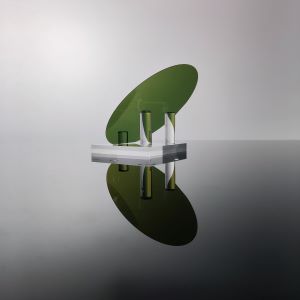
Introduction
As the demand for power electronic devices continues to grow, traditional silicon-based semiconductor materials are increasingly unable to meet the stringent requirements of modern high-temperature, high-voltage, and high-frequency applications. Silicon carbide (SiC), as an emerging wide bandgap semiconductor material, has become a key material for power semiconductor devices due to its excellent electrical and thermal properties. The silicon carbide homoepitaxial wafer, as the foundational technology in SiC device manufacturing, plays a critical role in improving device performance and reliability.
Technical Principles of Silicon Carbide Homoepitaxial Wafers
A silicon carbide homoepitaxial wafer refers to a wafer in which a layer of silicon carbide is epitaxially grown on a silicon carbide substrate using the same material. The epitaxial growth process employs techniques such as chemical vapor deposition (CVD), wherein gaseous SiC precursors are deposited onto the substrate surface at high temperatures, creating layers of high crystalline quality SiC. This process ensures that the epitaxial layer shares the same material properties as the substrate, forming a homoepitaxial structure.
The thickness, doping concentration, and crystalline quality of the epitaxial layer can be precisely controlled during the growth process, enabling it to meet specific requirements for different device characteristics. This makes silicon carbide homoepitaxial wafers indispensable in the fabrication of high-performance power devices.
Differences Between Silicon Carbide Homoepitaxial Wafers and Silicon Carbide Substrates
The functions of silicon carbide substrates and silicon carbide homoepitaxial wafers differ significantly in device manufacturing. A silicon carbide substrate is a wafer made from single-crystal silicon carbide, providing the mechanical support and electrical baseline for subsequent processes. It forms the foundational layer of the epitaxial wafer, offering a platform for epitaxial growth.
A silicon carbide homoepitaxial wafer, on the other hand, includes an epitaxial layer grown on top of the substrate, which serves as the active region in semiconductor devices. In high-performance power devices, the thickness and doping profile of the epitaxial layer determine key electrical characteristics, such as on-resistance and breakdown voltage. Therefore, while the substrate provides mechanical support, the epitaxial layer is the functional layer that directly enhances device performance.

Applications of Silicon Carbide Homoepitaxial Wafers
Due to the superior properties of silicon carbide, SiC homoepitaxial wafers are essential in various high-performance applications, including electric vehicles, renewable energy, 5G communications, industrial control, and more.
1. Power Semiconductor Devices: Silicon carbide MOSFETs and Schottky barrier diodes (SBDs) are key applications of SiC homoepitaxial wafers. Compared to traditional silicon-based devices, SiC devices exhibit higher breakdown voltages and lower switching losses, making them ideal for high-efficiency power conversion systems. These devices significantly reduce energy consumption and improve conversion efficiency in applications such as power supplies and inverters.
2. Electric Vehicles: Silicon carbide homoepitaxial wafers are used in power electronics systems for electric vehicles (EVs), enhancing vehicle energy efficiency and extending driving range. Inverters that incorporate SiC devices achieve higher energy conversion efficiency, reduce battery consumption, and increase overall vehicle performance.
3. Renewable Energy: In photovoltaic and wind energy systems, SiC power devices in inverters increase energy conversion efficiency, reduce system size and cost, and improve operational reliability. These advantages are crucial for enhancing the sustainability and cost-effectiveness of renewable energy systems.
4. 5G Communication: In 5G base stations, radio frequency (RF) power amplifiers require efficient, low-loss power management systems. SiC devices, with their high-frequency capabilities and superior thermal stability, are ideal for power management modules in 5G communication equipment.
5. Aerospace and Defense: The high-temperature stability and high breakdown field strength of silicon carbide make it indispensable in aerospace electronics, radar systems, and high-power transmission systems. These applications demand highly reliable performance in extreme conditions, where SiC devices excel.
6. Industrial Control and Power Management: Silicon carbide devices are widely used in industrial drives and power conversion systems. They significantly reduce energy losses and improve system reliability and efficiency, especially in high-power motor drives and smart grids.
Technical Advantages of Silicon Carbide Homoepitaxial Wafers
Compared to traditional silicon-based devices, silicon carbide homoepitaxial wafers offer several notable advantages:
High Breakdown Voltage: Silicon carbide has a much higher breakdown voltage than silicon, allowing devices to operate stably at higher voltages.
High-Temperature Operation: SiC devices can operate at temperatures exceeding 600°C, while silicon devices typically function up to around 150°C.
Low Switching Losses: SiC’s low switching losses make it particularly suitable for high-frequency switching applications, improving overall system efficiency.
High Thermal Conductivity: The thermal conductivity of silicon carbide is three times that of silicon, significantly enhancing heat dissipation, which is critical in high power-density applications.
Conclusion
Silicon carbide homoepitaxial wafers are a cornerstone of modern power semiconductor technology. With their outstanding electrical and thermal properties, they are driving innovation across multiple high-tech industries. As the demand for electric vehicles, renewable energy, and high-frequency communication technologies continues to surge, the application range and market demand for silicon carbide homoepitaxial wafers will only expand, holding immense potential for the future of power electronics.
As semiconductor technology advances, Gallium Nitride (GaN) has become a core material in optoelectronics, rad...
With the rapid advancement of third-generation semiconductor technologies, Silicon Carbide (SiC) has emerged a...
As third-generation semiconductor materials such as silicon carbide (SiC) and gallium nitride (GaN) continue t...
